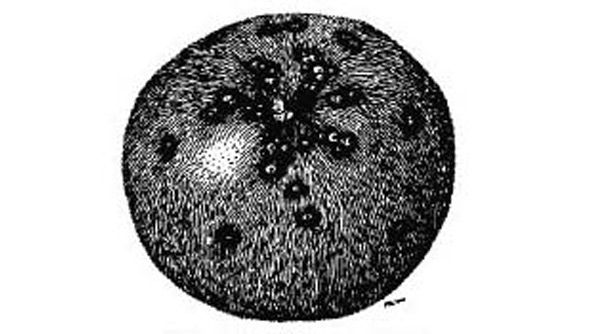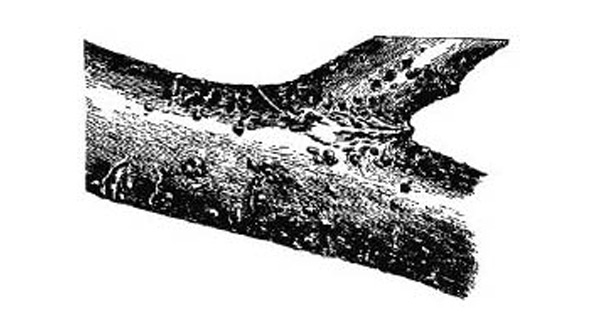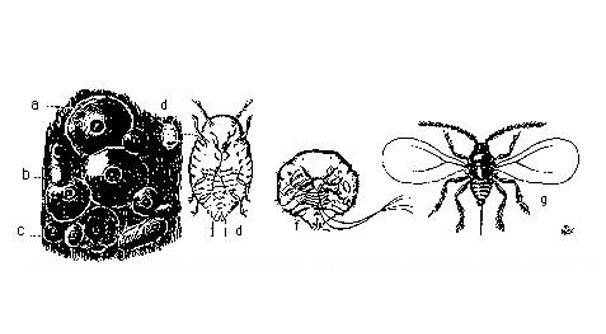Horticultural Pest and Disease Board
San Jose Scale on Fruit Trees
The San Jose scale was once a devastating pest of fruit trees. In 1922, more than 1,000 acres of mature apple trees were killed in southern Illinois by this insect. The scale was first introduced in the United States in 1870 in the San Jose Valley of California on nursery stock shipped from the Orient. With the introduction of the long-lasting chlorinated hydrocarbon insecticides, namely DDT, during World War II, San Jose scale disappeared from the scene and was no longer a threat to the commercial fruit producer.
In recent years, more and more San Jose scale-infested fruit samples have been reported from unsprayed fruit plantings. The insect is making a comeback in home plantings and in some commercial plantings.

Scale infestation on apple fruit
Classification
Quadraspidiotus perniciosus (Comstock), Order Homoptera, Family Diaspididae.
Damage
Infested trees show a general decrease in tree vigor, growth, and productivity. Under heavy infestation, twigs are crusted over with the scale, and smaller twigs and some branches are killed. On the fruit, feeding is most abundant around the blossom and stem ends and often results in a gray patch around the calyx of apples. Infested fruit has a spotted or mottled appearance because of a small red inflamed area surrounding each scale.

Scale infestation on apple branch
Hosts
San Jose scale attacks apple, pear, plum, sweet cherry, apricot, peach, nectarine, quince, currant, gooseberry and Osage orange.
Appearance and Life Cycle
The insect spends the winter in an immature stage (the second nymphal instar or black cap stage) fastened to twigs and larger branches of various fruit trees; the insect is about one-third grown. As temperatures warm to about 50 degrees F in the spring, the insect resumes growth. About the time trees are in bloom, two forms of scale can be found. One is nearly round, about 1.4 mm (1/20 inch) across, gray with a raised white knob in the center; these larger round scales cover the bodies of the female scales. The other form is oval and smaller, with a raised dot near the large end of the scale; these scales are the waxy covering of the males, which emerge as minute (1 mm long = 1/25 inch), yellow, two-winged insects. Females remain under the scales throughout their lives and after mating begin to give birth to living young; they do not lay eggs. Females continue to reproduce for about six weeks.
The young scales are very small, yellow mite-like insects with six well developed legs and two antennae. They are called crawlers because they crawl over the surface of the tree. Within 24 hours they find a place that is suitable to them, where they insert their slender thread-like mouthparts through the bark or fruit or leaf, and begin to suck sap. Soon after settling down to feed, crawlers shed their skin, legs, and antennae, and appear as flattened yellow sacks attached to the bark or fruit. As they continue to grow, the body secretes wax that hardens to form the characteristic San Jose scale. They reach maturity in six to eight weeks; there are two to three generations per year.

Adult female scale (a); male scale (b); young scale (c); crawler (d); female body under scale (f); Adult male (g)
Natural Enemies
Wasp parasitoids can attack San Jose scale. Predatory lady beetles also contribute to natural mortality. A fungus disease can infect San Jose scale when weather conditions are suitable. Natural enemies do not seem to attack scales quickly enough to prevent scales from causing permanent damage to the trees.
Detection and Monitoring
If twigs look unhealthy or are dead, examine them closely for the crusty scale. Examine twigs for scale during pruning operations. Look for the scales or their feeding blemishes on the fruit skin at harvest; if found, be prepared to control the scale the following spring. Adult male scales can be monitored by a pheromone (sex- attractant) trap. The small tent-style trap should be hung in a tree during the early pink bud stage. Males usually begin to fly at bloom or petal-fall. Once an emergence of adult males has been detected, the crawler stage can be predicted to appear about 500 degree-days (base 50 F) later, which is usually in about four to six weeks.
For the summer generation, crawlers are expected to appear about 600 degree-days (base 50 F) after a new flush of males appear in the traps. See North Central Regional Extension Publication 359, Insect Traps for Home Fruit Insect Control, for further information on where to buy traps.
Control
Once an infestation is detected, it is unlikely to go away and will probably continue to get worse if no action is taken. If an infestation is detected in its early stage, dormant pruning of infested wood can help control the problem.
The first step in scale control is to apply a dormant oil spray in the spring before growth starts. The dormant oil spray should be followed by a foliar insecticide spray directed at the crawler stage of the first generation; if crawlers are still emerging 10 days after the first foliar spray, then an additional spray may be needed. Additional foliar sprays should be directed at crawlers of the second and third generations. Although a foliar spray can be targeted at adult males during their flight and mating period, this is likely to be less effective than a spray directed at the crawlers. In backyard fruit plantings, an all-purpose fruit tree spray or the insecticide Imidan can be used for the foliar sprays.
The author gratefully acknowledges Richard L. Miller for his 1985 fact sheet on which this is based.
Warning: The law requires that pesticides be used as the label directs. There are permissible exceptions to product applications: more dilute sprays than on the label; use of lower rates; less frequency than on the label; for pests not on the label, as long as site or crop is on the label and other directions are observed.
Use pesticides with care. Apply them only to plants, animals, or sites listed on the label. When mixing and applying pesticides, follow all label precautions to protect yourself and others around you. It is a violation of the law to disregard label directions. If pesticides are spilled on skin or clothing, remove clothing and wash skin thoroughly. Store pesticides in their original containers and keep them out of the reach of children, pets, and livestock.
Posted: 12/31/2014 11:48 AM
Last Updated: 01/07/2015 11:15 AM